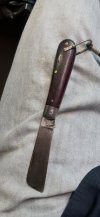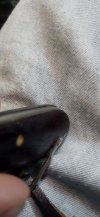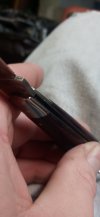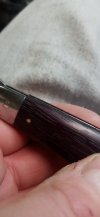RickHuf
Gold Member
- Joined
- Jan 19, 2023
- Messages
- 2,109
Hello everyone.
I have had a lot of fun recovering a handful of knives this year. Three of them, though, have decided to expand or contract.
Here is an example. I just found this one today (haven't used it in a while) This is a Klein knife that was recovered in purpleheart. Please disregard my awful looking stainless pivot pin.




When I had finished, this wood was completely flush everywhere. Now it's overhanging the liners and bolsters.
This happened to a fixed blade that I covered in ebony as well. The wood overhangs even more on it than the one shown above.
A third was covered in locust and it actually shrunk a wee bit! This I had blamed on not drying out my wood enough, but I don't know. I baked it for a few 8 hour shifts at 180f.
All three of these seemed to appear this way over a month or two later. The wood covers are epoxied to the liners/tang before shaping and finishing. They are all oiled with linseed and polished a couple weeks later.
What am I doing wrong here? Does anyone have any ideas? I know wood expands and contracts, but it's getting to the cold season and this stuff shouldn't be expanding at this point. It's all super hard wood, too.
Do I dare sand these and refinish them only to find the wood has shrunk again at a later point?
Thanks for any consideration!
I have had a lot of fun recovering a handful of knives this year. Three of them, though, have decided to expand or contract.
Here is an example. I just found this one today (haven't used it in a while) This is a Klein knife that was recovered in purpleheart. Please disregard my awful looking stainless pivot pin.




When I had finished, this wood was completely flush everywhere. Now it's overhanging the liners and bolsters.
This happened to a fixed blade that I covered in ebony as well. The wood overhangs even more on it than the one shown above.
A third was covered in locust and it actually shrunk a wee bit! This I had blamed on not drying out my wood enough, but I don't know. I baked it for a few 8 hour shifts at 180f.
All three of these seemed to appear this way over a month or two later. The wood covers are epoxied to the liners/tang before shaping and finishing. They are all oiled with linseed and polished a couple weeks later.
What am I doing wrong here? Does anyone have any ideas? I know wood expands and contracts, but it's getting to the cold season and this stuff shouldn't be expanding at this point. It's all super hard wood, too.
Do I dare sand these and refinish them only to find the wood has shrunk again at a later point?
Thanks for any consideration!

